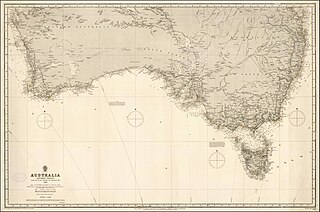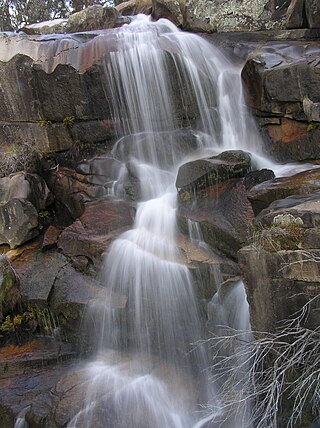
The Nightcap National Park is a national park situated within the Nightcap Range in the Northern Rivers region of New South Wales, Australia. The 8,080-hectare (20,000-acre) park was created in April 1983 and is situated 35 kilometres (22 mi) north of Lismore. The park was established following campaigns and blockades against logging at Terania Creek, Grier's Scrub and Mount Nardi between 1979 and 1982. Sections of the Whian Whian state forest were added to it following blockading and campaigning in 1998. The national park is classed by the IUCN World Commission on Protected Areas as Category II and is part of the Shield Volcano Group of the World Heritage Site Gondwana Rainforests of Australia inscribed in 1986 and added to the Australian National Heritage List in 2007.

Fitzgerald River National Park is a national park in the Shires of Ravensthorpe and the Jerramungup in Western Australia, 419 kilometres (260 mi) southeast of Perth. The park is recognised on Australia's National Heritage List for its outstanding diversity of native plant species, including many plants which are unique to the local area.
In Australian parliamentary practice, the Opposition, Official Opposition or His Majesty's Most Loyal Opposition consists of the second largest party or coalition of parties in the Australian House of Representatives, with its leader being given the title Leader of the Opposition. The Opposition serves the same function as the official opposition in other Commonwealth of Nations monarchies that follow the Westminster conventions and practices. It is seen as the alternative government and the existing administration's main opponent in the Australian Parliament and at a general election. By convention, the Opposition Leader in the federal Parliament comes from the House of Representatives, as does the deputy, although the Government and Opposition may also both have leaders in the Senate. The Opposition is sometimes styled as His Majesty's Loyal Opposition to show that, although the group may be against the sitting government, it remains loyal to the Crown, and thus to Australia.
This is a timeline of Australian history, comprising important legal and territorial changes and political events in Australia and its predecessor states. To read about the background to these events, see history of Australia. See also the list of prime ministers of Australia.
The Australian Department of the Environment was a department of the Government of Australia that existed between September 2013 and July 2016. The department was charged with responsibility for developing and implementing national policy, programs and legislation to protect and conserve Australia's environment and heritage.

The term Southern Australia is generally considered to refer to the states and territories of Australia of New South Wales, Victoria, Tasmania, the Australian Capital Territory and South Australia. The part of Western Australia south of latitude 26° south — a definition widely used in law and state government policy — is also usually included.

The eastern bettong, also known as the southern or Tasmanian bettong, is a small, hopping, rat-like mammal native to grassy forests of southeastern Australia and Tasmania. A member of the rat-kangaroo family (Potoroidae), it is active at night and feeds on fungi and plant roots. Like most marsupials, it carries its young in a pouch. The eastern bettong is under pressure by introduced predators and habitat loss. The subspecies on mainland Australia is extinct, but populations of the Tasmanian subspecies have been reintroduced there.
Kembla Heights is a village west of Wollongong, New South Wales in the Parish of Kembla County of Camden. It is situated along Harry Graham Drive and upper Cordeaux Road and is part of a tourist route that runs along the Illawarra escarpment for a distance between Mount Kembla and Mount Keira. The Dendrobium Colliery is located in Kembla Heights.

Captain Trevor Jackson is an Australian technical diver, shipwreck researcher, author and inventor. In 2002 he staged what became known as the "Centaur Dive", which subsequently led to the gazetted position of the sunken Hospital Ship AHS Centaur being questioned. Jackson is the inventor of the 'Sea Tiger' lost diver location system, and an author on the subject of wreck diving.

Australian Convict Sites is a World Heritage property consisting of 11 remnant penal sites originally built within the British Empire during the 18th and 19th centuries on fertile Australian coastal strips at Sydney, Tasmania, Norfolk Island, and Fremantle; now representing "...the best surviving examples of large-scale convict transportation and the colonial expansion of European powers through the presence and labour of convicts".
The Australian Faunal Directory (AFD) is an online catalogue of taxonomic and biological information on all animal species known to occur within Australia. It is a program of the Department of Climate Change, Energy, the Environment and Water of the Government of Australia. By May 12, 2021, the Australian Faunal Directory has collected information about 126,442 species and subspecies. It includes the data from the discontinued Zoological Catalogue of Australia and is regularly updated. Started in the 1980s, it set a goal to compile a "list of all Australian fauna including terrestrial vertebrates, ants and marine fauna" and create an "Australian biotaxonomic information system". This important electronic key and educative package enables faster and orderly identification of Australian centipede species.
Roadside conservation is a conservation strategy in Australia and other countries where Road verge flora and habitats are protected or improved. The general aim is to conserve or increase the amount of native flora species; especially where that work will lead to higher conservation value, for example providing food or habitat for rare or endangered native fauna.

The Gibraltar Falls are a cascade waterfall on the Gibraltar Creek, in the Australian Capital Territory (ACT), approximately 50 kilometres from Canberra's city centre, The falls have a 50-metre (160-foot) drop.
The Gibraltar Range is a mountain range in the Northern Tablelands region of New South Wales, Australia. The range extends off the Great Dividing Range at Bald Nob about 25 kilometres (16 mi) east northeast of Glen Innes and trends generally east northeast and north northeast for about 100 kilometres (62 mi) to the junction of Timbarra and Clarence rivers. It forms the watershed between these two rivers.

James Henry Griffin [born Manly] is an Australian politician. He is a member of the New South Wales Legislative Assembly representing the electoral district of Manly for the Liberal Party. Griffin was the New South Wales Minister for Environment and Heritage in the Second Perrottet ministry from December 2021 to March 2023.

The Ningaloo Marine Park is an Australian marine park offshore of Western Australia, and west of the Ningaloo Coast. The marine park covers an area of 2,435 km2 (940 sq mi) and is assigned IUCN category IV. It is one of the 13 parks managed under the North-west Marine Parks Network.
This is a list of places on the Commonwealth Heritage List in Western Australia. The Commonwealth Heritage List is a heritage register which lists places of historic, cultural and natural heritage on Commonwealth land or in Commonwealth waters, or owned or managed by the Commonwealth Government. To be listed, a place has to meet one or more of the nine Commonwealth Heritage List criteria.









